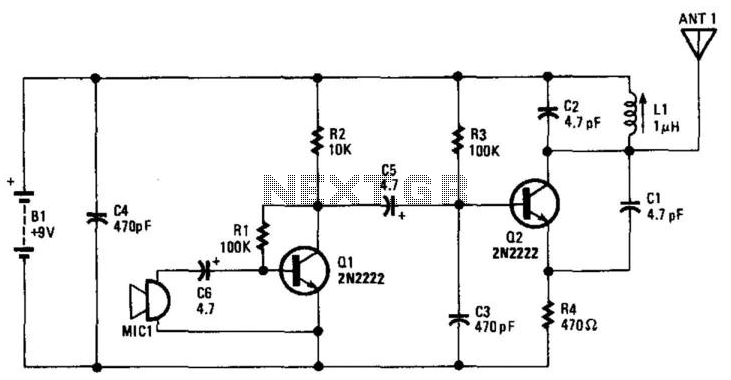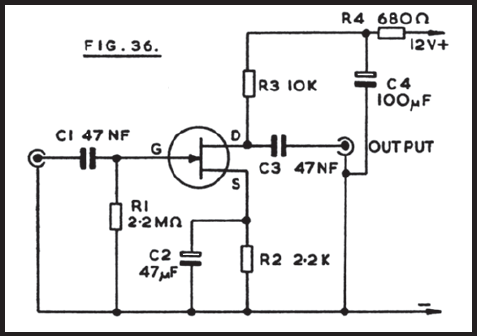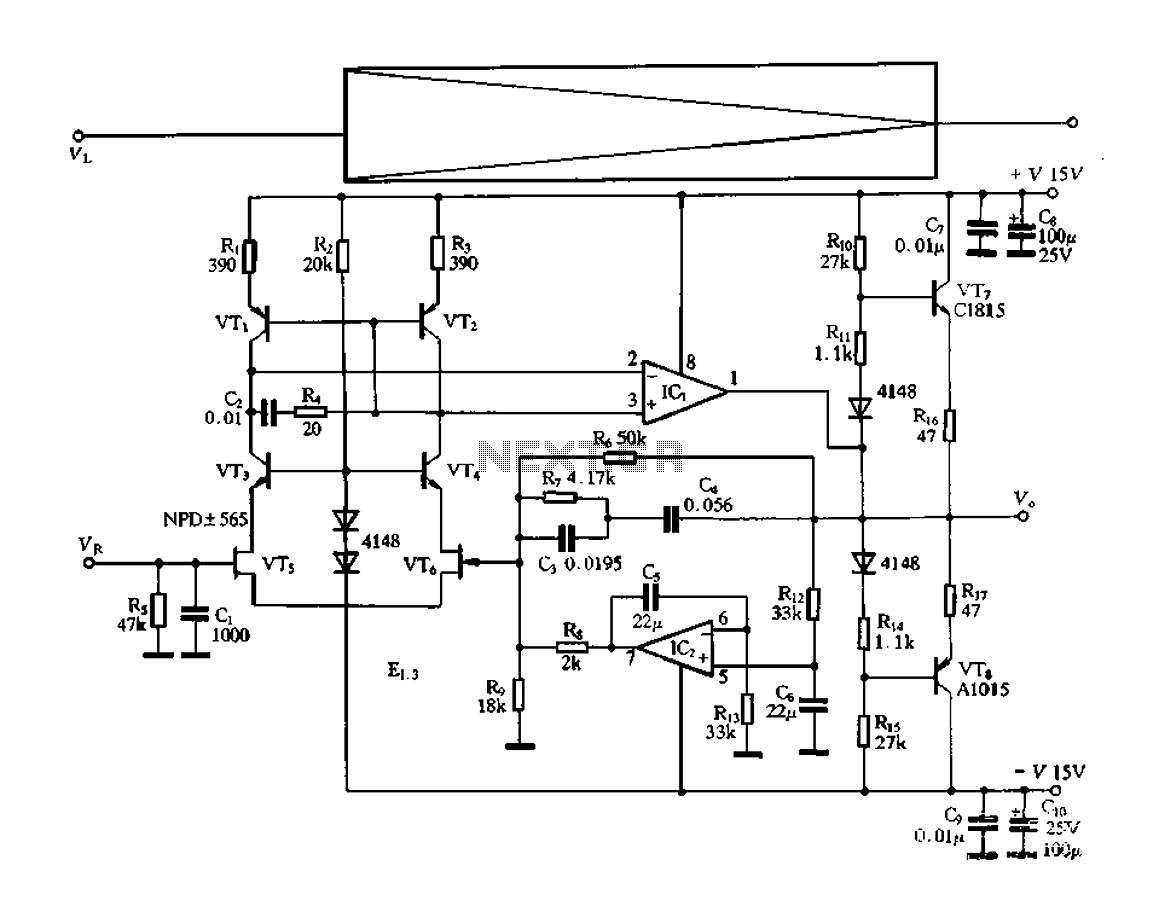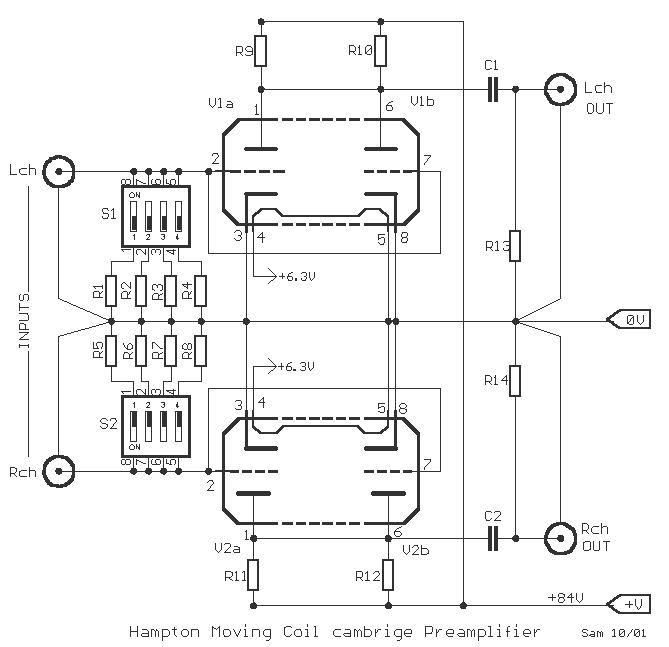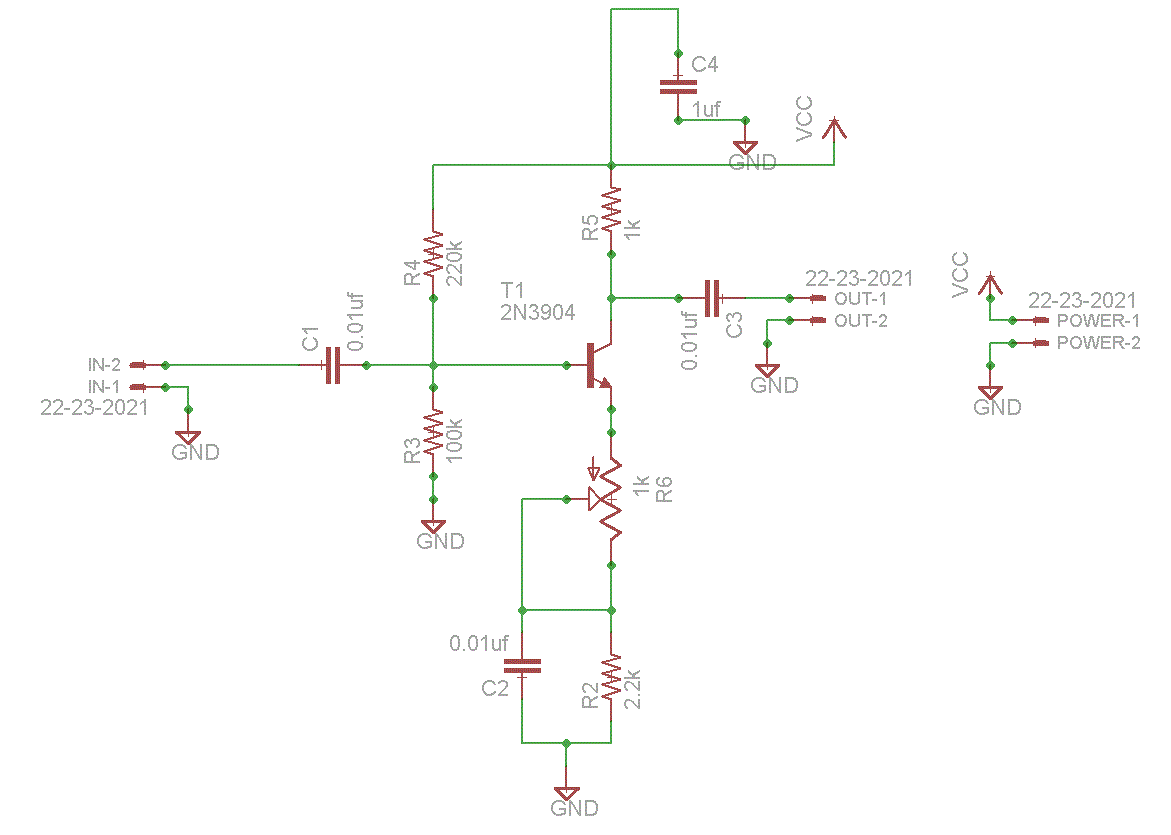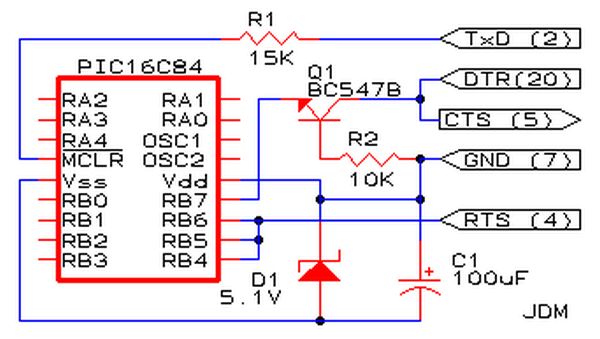
ECM Mic Preamp Project
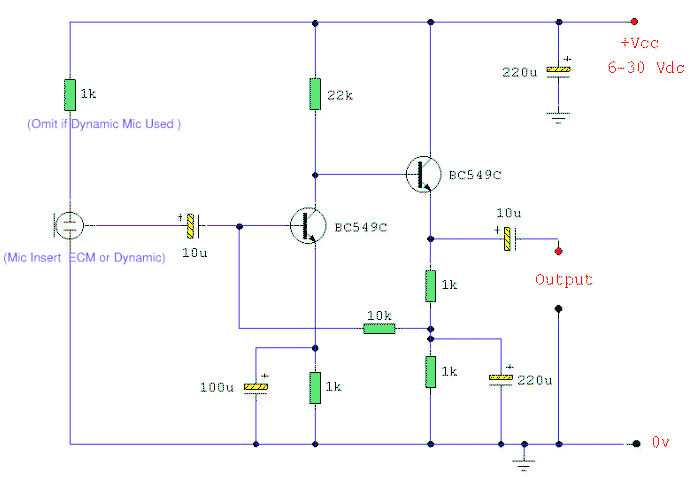
Both transistors should be low noise types. In the original circuit, BC650C was used, which is an ultra-low noise device. These transistors are now hard to find, but BC549C or BC109C are good replacements. The circuit is self-biasing and will set its quiescent point at roughly half the supply voltage at the emitter of the last transistor. The electret condenser microphone (ECM) contains a very sensitive microphone element and an internal FET preamp, requiring a power supply in the range of 2 to 10 volts DC. Suitable ECMs may be obtained from Maplin Electronics. The 1k resistor limits the current to the microphone. This resistor should be increased to 2.2k if a supply voltage above 12 volts DC is used and is not needed if the microphone insert is dynamic. The output impedance is very low and well-suited for driving cables over distances up to 50 meters, thus screening is not necessary. The noise response of the amplifier measured across the 10k load is shown below. Note that this plot was made with the microphone insert replaced by a signal generator. This preamplifier has excellent dynamic range and can handle signals from a whisper to a loud shout; however, care should be taken to ensure that the auxiliary equipment, such as an amplifier or tape deck, does not overload.
The circuit described utilizes low-noise transistors to minimize signal interference, enhancing the performance of the electret condenser microphone (ECM). The choice of transistors, such as BC549C or BC109C, serves as a suitable alternative to the now-scarce BC650C. The self-biasing mechanism of the circuit allows it to automatically adjust the quiescent point, optimizing the operation of the final transistor by maintaining it at approximately half the supply voltage. This feature is crucial for maintaining consistent performance across varying operating conditions.
The ECM, characterized by its sensitive microphone element and integrated FET preamp, requires a DC power supply between 2 to 10 volts. The selection of ECMs from reliable suppliers, like Maplin Electronics, ensures quality and performance. The inclusion of a 1k resistor in the circuit serves to limit the current supplied to the microphone, which is essential for preventing damage to the microphone element. In instances where the supply voltage exceeds 12 volts DC, it is advisable to increase this resistor to 2.2k to further protect the microphone. Conversely, if a dynamic microphone insert is utilized, the resistor may be omitted entirely.
The circuit's design facilitates low output impedance, making it adept at driving signal cables over extended distances, up to 50 meters, without the need for screened cables. This feature is particularly beneficial in applications where cable runs may be long, as it reduces the risk of signal degradation. The noise response characteristics of the amplifier, as measured across a 10k load, demonstrate the circuit's effectiveness. It is important to note that the performance plots were generated with a signal generator in place of the microphone insert, allowing for an assessment of the amplifier's capabilities.
This preamplifier design boasts an excellent dynamic range, accommodating a wide variety of input levels, from faint whispers to loud shouts. However, it is crucial to ensure that any connected auxiliary equipment, such as amplifiers or tape decks, are not subjected to overload conditions, which could compromise the integrity of the audio signal. Overall, this circuit design exemplifies a well-engineered solution for audio amplification in various applications, ensuring high fidelity and low noise performance.Both transistors should be low noise types. In the original circuit, I used BC650C which is an ultra low noise device. These transistors are now hard to find but BC549C or BC109C are a good replacement. The circuit is self biasing and will set its quiescent point at roughly half the supply voltage at the emitter of the last transistor. The electre t condenser microphone (ECM) contains a very sensitive microphone element and an internal FET preamp, a power supply in the range 2 to 10 volts DC is therefore necessary. Suitable ECM`s may be obtained from Maplin Electronics. The 1k resistor limits the current to the mic. This resistor should be increased to 2k2 if a supply voltage above 12 Volts DC is used and is not needed if the Mic insert is dynamic.
The output impedance is very low and well suited to driving cables over distances up to 50 meters. Screened cable therefore is not necessary. The noise response of the amplifier measured across the 10k load is shown below. Please note that this plot was made with the mic insert replaced by a signal generator. This preamplifier has excellent dynamic range and can cope with anything from a whisper to a loud shout, however care should be taken to make sure that the auxiliary equipment i. e. amplifier or tape deck does not overload. 🔗 External reference
The circuit described utilizes low-noise transistors to minimize signal interference, enhancing the performance of the electret condenser microphone (ECM). The choice of transistors, such as BC549C or BC109C, serves as a suitable alternative to the now-scarce BC650C. The self-biasing mechanism of the circuit allows it to automatically adjust the quiescent point, optimizing the operation of the final transistor by maintaining it at approximately half the supply voltage. This feature is crucial for maintaining consistent performance across varying operating conditions.
The ECM, characterized by its sensitive microphone element and integrated FET preamp, requires a DC power supply between 2 to 10 volts. The selection of ECMs from reliable suppliers, like Maplin Electronics, ensures quality and performance. The inclusion of a 1k resistor in the circuit serves to limit the current supplied to the microphone, which is essential for preventing damage to the microphone element. In instances where the supply voltage exceeds 12 volts DC, it is advisable to increase this resistor to 2.2k to further protect the microphone. Conversely, if a dynamic microphone insert is utilized, the resistor may be omitted entirely.
The circuit's design facilitates low output impedance, making it adept at driving signal cables over extended distances, up to 50 meters, without the need for screened cables. This feature is particularly beneficial in applications where cable runs may be long, as it reduces the risk of signal degradation. The noise response characteristics of the amplifier, as measured across a 10k load, demonstrate the circuit's effectiveness. It is important to note that the performance plots were generated with a signal generator in place of the microphone insert, allowing for an assessment of the amplifier's capabilities.
This preamplifier design boasts an excellent dynamic range, accommodating a wide variety of input levels, from faint whispers to loud shouts. However, it is crucial to ensure that any connected auxiliary equipment, such as amplifiers or tape decks, are not subjected to overload conditions, which could compromise the integrity of the audio signal. Overall, this circuit design exemplifies a well-engineered solution for audio amplification in various applications, ensuring high fidelity and low noise performance.Both transistors should be low noise types. In the original circuit, I used BC650C which is an ultra low noise device. These transistors are now hard to find but BC549C or BC109C are a good replacement. The circuit is self biasing and will set its quiescent point at roughly half the supply voltage at the emitter of the last transistor. The electre t condenser microphone (ECM) contains a very sensitive microphone element and an internal FET preamp, a power supply in the range 2 to 10 volts DC is therefore necessary. Suitable ECM`s may be obtained from Maplin Electronics. The 1k resistor limits the current to the mic. This resistor should be increased to 2k2 if a supply voltage above 12 Volts DC is used and is not needed if the Mic insert is dynamic.
The output impedance is very low and well suited to driving cables over distances up to 50 meters. Screened cable therefore is not necessary. The noise response of the amplifier measured across the 10k load is shown below. Please note that this plot was made with the mic insert replaced by a signal generator. This preamplifier has excellent dynamic range and can cope with anything from a whisper to a loud shout, however care should be taken to make sure that the auxiliary equipment i. e. amplifier or tape deck does not overload. 🔗 External reference
